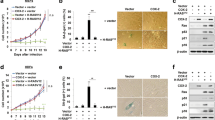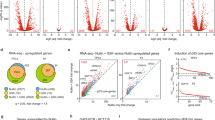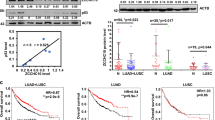Abstract
Cyclooxygenase-2 (COX-2) has been implicated in a variety of human malignancies and, accordingly, COX-2 selective inhibitors are being investigated as important chemopreventive and therapeutic agents. How COX-2 overexpression results in tumorigenesis and how COX-2 selective agents mediate their chemopreventive effects are issues that remain poorly understood. Here we report that the tumor suppressor p53 upregulates COX-2 expression and that COX-2 can in turn inhibit p53-dependent transcription. Additionally, a COX-2-selective inhibitor potentiates p53-induced apoptosis, which also supports the notion that COX-2 activity appears to interfere with p53 function. Expression of exogenous COX-2 in p53 wild-type cells does not affect the cytoplasmic or nuclear levels of p53, suggesting that COX-2 may not affect p53 turnover or subcellular localization. We further demonstrate that endogenous COX-2 interacts with p53 and that COX-2 and p53 interactions are a physiologically relevant event. Thus, p53 upregulates COX-2 and COX-2 in turn appears to negatively affect p53 activity via mechanisms that could involve physical interactions between COX-2 and p53. Based on our results, we propose that p53-dependent upregulation and activation of COX-2 appear to be yet another novel mechanism by which p53 could abate its own growth-inhibitory and apoptotic effects.
This is a preview of subscription content, access via your institution
Access options
Subscribe to this journal
Receive 50 print issues and online access
$259.00 per year
only $5.18 per issue
Buy this article
- Purchase on Springer Link
- Instant access to full article PDF
Prices may be subject to local taxes which are calculated during checkout





Similar content being viewed by others
References
Alarcon-Vargas D and Ronai Z . (2002). Carcinogenesis, 23, 541–547.
Corcoran CA, Huang Y and Sheikh MS . (2004). Cancer Biol. Ther., 3, 721–725.
Dornan D, Wertz I, Shimizu H, Arnott D, Frantz GD, Dowd P, O'Rourke K, Koeppen H and Dixit VM . (2004). Nature, 429, 86–92.
Gallo O, Schiavone N, Papucci L, Sardi I, Magnelli L, Franchi A, Masini E and Capaccioli S . (2003). Am. J. Pathol., 163, 723–732.
Giaccia AJ and Kastan MB . (1998). Genes Dev., 12, 2973–2983.
Grewal S, Ponnambalam S and Walker JH . (2003). J. Cell. Sci., 116, 2303–2310.
Grosch S, Tegeder I, Niederberger E, Brautigam L and Geisslinger G . (2001). FASEB J., 15, 2742–2744.
Han J, Flemington C, Houghton AB, Gu Z, Zambetti GP, Lutz RJ, Zhu L and Chittenden T . (2001). Proc. Natl. Acad. Sci. USA, 98, 11318–11323.
Han JA, Kim JI, Ongusaha PP, Hwang DH, Ballou LR, Mahale A, Aaronson SA and Lee SW . (2002). EMBO J., 21, 5635–5644.
Hofseth LJ, Hussain SP and Harris CC . (2004). Trends Pharmacol. Sci., 25, 177–181.
Huang Y, He Q, Hillman MJ, Rong R and Sheikh MS . (2001). Cancer Res., 61, 6918–6924.
Jones DA, Carlton DP, McIntyre TM, Zimmerman GA and Prescott SM . (1993). J. Biol. Chem., 268, 9049–9054.
Kulp SK, Yang YT, Hung CC, Chen KF, Lai JP, Tseng PH, Fowble JW, Ward PJ and Chen CS . (2004). Cancer Res., 64, 1444–1451.
Leng RP, Lin Y, Ma W, Wu H, Lemmers B, Chung S, Parant JM, Lozano G, Hakem R and Benchimol S . (2003). Cell, 112, 779–791.
Liou JY, Deng WG, Gilroy DW, Shyue SK and Wu KK . (2001). J. Biol. Chem., 276, 34975–34982.
Lloyd DR and Hanawalt PC . (2002). Cancer Res., 62, 5288–5294.
Luo X, Huang Y and Sheikh MS . (2003). Oncogene, 22, 7247–7257.
Majumder M, Ghosh AK, Steele R, Ray R and Ray RB . (2001). J. Virol., 75, 1401–1407.
Morita I, Schindler M, Regier MK, Otto JC, Hori T, DeWitt DL and Smith WL . (1995). J. Biol. Chem., 270, 10902–10908.
Nakano K and Vousden KH . (2001). Mol. Cell, 7, 683–694.
Nikolaev AY, Li M, Puskas N, Qin J and Gu W . (2003). Cell, 112, 29–40.
Seo YR, Fishel ML, Amundson S, Kelley MR and Smith ML . (2002). Oncogene, 21, 731–737.
Sheikh MS, Burns TF, Huang Y, Wu GS, Amundson S, Brooks KS, Fornace Jr AJ and el-Deiry WS . (1998). Cancer Res., 58, 1593–1598.
Sheikh MS and Fornace Jr AJ . (2000). J. Cell Physiol., 182, 171–181.
Shureiqi I, Xu X, Chen D, Lotan R, Morris JS, Fischer SM and Lippman SM . (2001). Cancer Res., 61, 4879–4884.
Smigel K . (2000). J. Natl. Cancer Inst., 92, 297–299.
Spencer AG, Woods JW, Arakawa T, Singer II and Smith WL . (1998). J. Biol. Chem., 273, 9886–9893.
Subbaramaiah K, Altorki N, Chung WJ, Mestre JR, Sampat A and Dannenberg AJ . (1999). J. Biol. Chem., 274, 10911–10915.
Swamy MV, Herzog CR and Rao CV . (2003). Cancer Res., 63, 5239–5242.
Thun MJ, Henley SJ and Partrono C . (2002). J. Natl. Cancer Inst., 94, 252–266.
Trifan OC, Smith RM, Thompson BD and Hla T . (1999). J. Biol. Chem., 274, 34141–34147.
Wang W and El-Deiry WS . (2003). Cancer Biol. Ther., 2, 196–202.
Williams CS, Mann M and DuBois RN . (1999). Oncogene, 18, 7908–7916.
Yu J, Zhang L, Hwang PM, Kinzler KW and Vogelstein B . (2001). Mol. Cell, 7, 673–682.
Yu J, Zhang L, Hwang PM, Rago C, Kinzler KW and Vogelstein B . (1999). Proc. Natl. Acad. Sci. USA, 96, 14517–14522.
Acknowledgements
We thank Dr Bert Vogelstein for providing the p53-inducible DLD1 human colon cancer cells as well as pCMV-p53 and PG13-Luc constructs. We thank Dr Richard Kulmacz for providing us with the pSG5-COX-2 expression vector. Also, we thank Dr Thomas Chittenden for providing us with pGL3-PUMA promoter construct. This work was supported in part by the National Institutes of Health Grants CA105300, CA086945 and United States Army PCRP Grant PC030519.
Author information
Authors and Affiliations
Corresponding author
Rights and permissions
About this article
Cite this article
Corcoran, C., He, Q., Huang, Y. et al. Cyclooxygenase-2 interacts with p53 and interferes with p53-dependent transcription and apoptosis. Oncogene 24, 1634–1640 (2005). https://doi.org/10.1038/sj.onc.1208353
Received:
Revised:
Accepted:
Published:
Issue Date:
DOI: https://doi.org/10.1038/sj.onc.1208353
Keywords
This article is cited by
-
Cyclooxygenase-2 induces neoplastic transformation by inhibiting p53-dependent oncogene-induced senescence
Scientific Reports (2021)
-
Restoration of tumor suppressor p53 by differentially regulating pro- and anti-p53 networks in HPV-18-infected cervical cancer cells
Oncogene (2012)
-
Cyclooxygenase inhibitors modulate the p53/HDM2 pathway and enhance chemotherapy-induced apoptosis in neuroblastoma
Oncogene (2007)
-
Cyclo-oxygenase-2 (Cox-2) expression and resistance to platinum versus platinum/paclitaxel containing chemotherapy in advanced ovarian cancer
BMC Cancer (2006)
-
Comparison of gene expression profiles in core biopsies and corresponding surgical breast cancer samples
Breast Cancer Research (2006)



